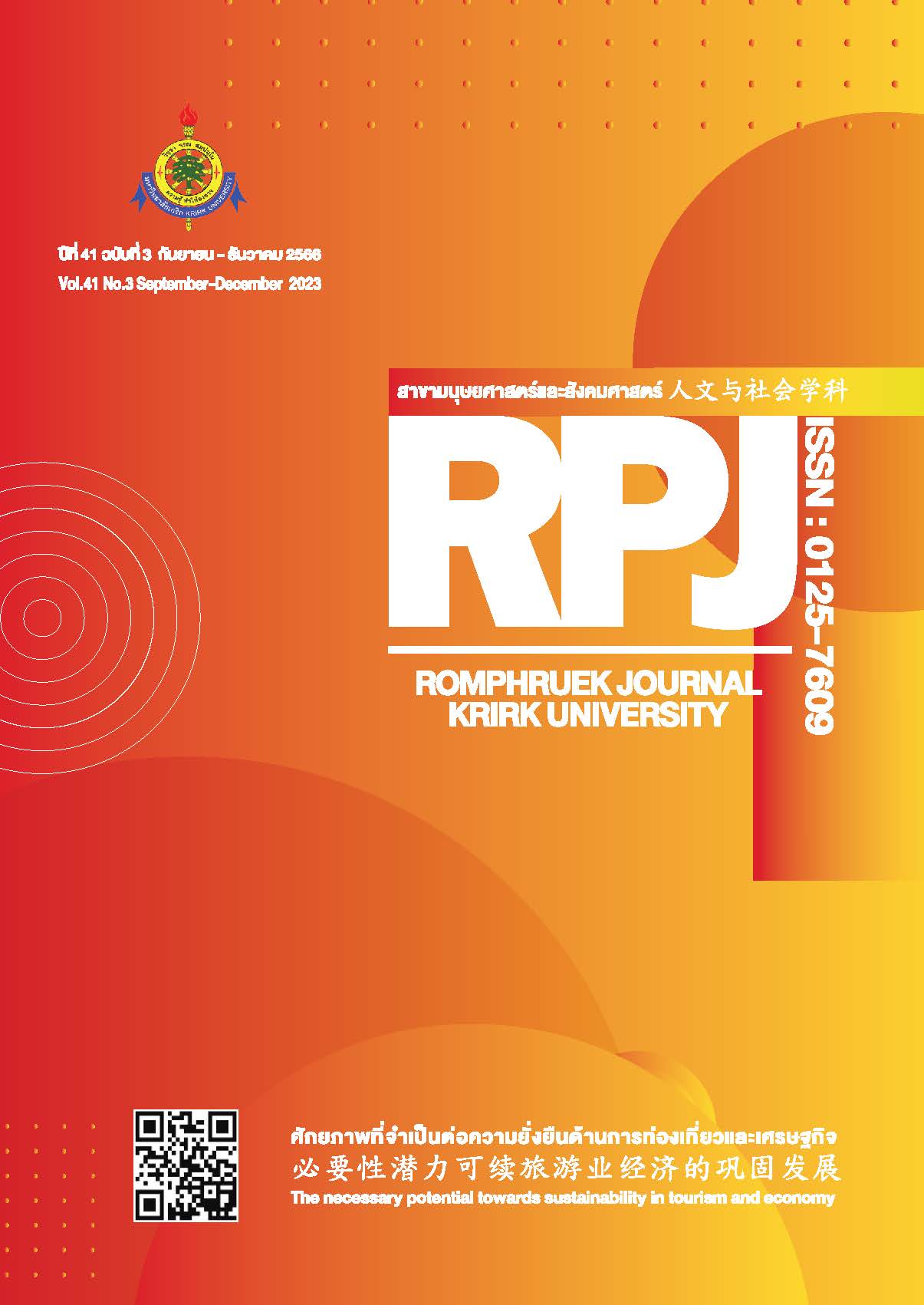แรงจูงใจและสภาพแวดล้อมในการทำงานที่มีอิทธิพลต่อประสิทธิภาพของทีมงาน
Main Article Content
บทคัดย่อ
บทความนี้มีวัตถุประสงค์เพื่อ 1) ศึกษาสภาพแวดล้อมในการทำงานที่มีอิทธิพลต่อแรงจูงใจในการปฏิบัติงานของพนักงาน 2) ศึกษาแรงจูงใจในการปฏิบัติงานของพนักงานที่มีอิทธิพลต่อประสิทธิภาพของทีมงาน และ 3) ศึกษาสภาพแวดล้อมในการทำงานที่มีอิทธิพลต่อประสิทธิภาพของทีมงานและส่งผ่านแรงจูงใจในการปฏิบัติงาน งานวิจัยนี้เป็นการวิจัยเชิงปริมาณ กลุ่มตัวอย่างที่ใช้ในงานวิจัยครั้งนี้คือพนักงานในกลุ่มอุตสาหกรรมไฟฟ้าและอิเล็กทรอนิกส์ จำนวน 420 ตัวอย่าง โดยใช้แบบสอบถามเป็นเครื่องมือในการรวบรวมข้อมูล ทำการวิเคราะห์ข้อมูลด้วยสถิติเชิงพรรณนา ได้แก่ ค่าความถี่ ค่าร้อยละ ค่าเฉลี่ย และส่วนเบี่ยงเบนมาตรฐาน และทดสอบสมมติฐานด้วยการวิเคราะห์แบบจำลองสมการโครงสร้างกำลังสองน้อยที่สุดบางส่วน (PLS-SEM)
ผลการวิจัยพบว่า การวิเคราะห์แบบจำลองการวัดมีค่าเฉลี่ยของความแปรปรวนที่ถูกสกัดได้มีความเที่ยงตรง โดยมีค่าตั้งแต่ .5191 ถึง .5918 และมีความเชื่อถือได้ โดยมีค่าน้ำหนักตัวชี้วัดตั้งแต่ .5898 ถึง .8429 สำหรับผลการวิเคราะห์แบบจำลองโครงสร้างมีคุณภาพดีโดยมีค่าค่า R2 ของตัวแปรแรงจูงใจและประสิทธิภาพมีค่าเท่ากับ .7049 และ .8301 ตามลำดับซึ่งอยู่ในระดับกลางค่อนข้างไปทางระดับพอเพียง การวิเคราะห์อิทธิพลของตัวแปรใน 3 เส้นทาง มีผลดังนี้ 1) เส้นทางสภาพแวดล้อมในการทำงาน ไปสู่ประสิทธิภาพของทีมงาน เป็นเส้นทางที่มีขนาดผลกระทบรวมใหญ่ที่สุดเท่ากับ 0.8618 และมีผลกระทบทั้งทางตรงและทางอ้อม มีค่าขนาดอิทธิพลขนาดกลางเท่ากับ 0.2844 รองลงมาเป็น 2) เส้นทางสภาพแวดล้อมในการทำงานไปสู่แรงจูงใจ เป็นเส้นทางที่มีขนาดผลกระทบรวมเท่ากับ 0.8396 โดยเป็นผลกระทบทางตรงทั้งหมด มีค่าขนาดอิทธิพลขนาดใหญ่เท่ากับ 2.3893 และ 3) เส้นทางแรงจูงใจไปสู่ประสิทธิภาพของทีมงาน เป็นเส้นทางที่มีขนาดผลกระทบเท่ากับ 0.5445 โดยเป็นผลกระทบทางตรงทั้งหมด ค่าขนาดอิทธิพลขนาดกลางเท่ากับ 0.5150 ใน งานวิจัยนี้ได้ค้นพบว่า สภาพแวดล้อมในการทำงานที่ส่งผลให้ประสิทธิภาพทีมงานจะเพิ่มขึ้นนั้น จะต้องส่งผ่านแรงจูงใจในการปฏิบัติงานของพนักงานด้วย
Article Details

อนุญาตภายใต้เงื่อนไข Creative Commons Attribution-NonCommercial-NoDerivatives 4.0 International License.
ทุกบทความที่ตีพิมพ์ในวารสารมนุษยศาสตร์และสังคมศาสตร์ร่มพฤกษ์เป็นทัศนะและข้อคิดเห็นของผู้เขียนมิใช่ทัศนะของมหาวิทยาลัยเกริกหรือกองบรรณาธิการ การนำบทความส่วนใดส่วนหนึ่งหรือทั้งหมดไปพิมพ์เผยแพร่ต้องอ้างอิงที่มาให้ชัดเจน
เอกสารอ้างอิง
กฤษดา เชียรวัฒนสุข สันติกร ภมรปฐมกุล และวิจิตตรา ผลมะม่วง. (2562). แรงจูงใจและบรรยากาศองค์กรที่มีความสัมพันธ์กับผลการปฏิบัติงานของพนักงาน กรณีศึกษา บริษัท โซนี่ เทคโนโลยี (ประเทศไทย) จำกัด. วารสารวิทยาการจัดการมหาวิทยาลัยราชภัฎนครปฐม, 6(2), 36-49.
กฤษดา เชียรวัฒนสุข นิกร ลีชาคำ และมรกต จันทร์กระพ้อ. (2562). สภาพแวดล้อมในการทำงานและแรงจูงในที่มีผลต่อประสิทธิภาพทีมงาน: ข้อมูลเชิงประจักษ์จากบริษัทผลิตอุปกรณ์คอมพิวเตอร์แห่งหนึ่ง. วารสารวิชาการ มหาวิทยาลัยกรุงเทพธนบุรี, 8(2), 219-230.
กมลพร กัลยาณมิตร. (2559). แรงจูงใจ 2 ปัจจัย พลังสู่ความสำเร็จ. วารสารวไลยอลงกรณ์ปริทัศน์ (มนุษยศาสตร์และสังคมศาสตร์), 6(3), 175-183.
ชุติมา มาลัย. (2538). ความสัมพันธ์ระหว่างสภาพแวดล้อมในการทำงานกับการทำงานเป็นทีมของอาจารย์พยาบาลวิทยาลัยพยาบาล สังกัดกระทรวงสาธารณสุข. จุฬาลงกรณ์มหาวิทยาลัย.
เนตร์พัณณา ยาวิราช. (2547). การจัดการสมัยใหม่ (พิมพ์ครั้งที่ 3). เซ็นทรัลเอ็กซ์เพรส.
เบญจมาศ นิลกำแหง เสาวนีย์ สิกขาบัณฑิต และกาญจนา บุญภักดิ์. (2564). รูปแบบการพัฒนาทีมงานที่มีประสิทธิภาพในสถานศึกษาสังกัดสำนักงานเขตพื้นที่การศึกษาประถมศึกษาสมุทรปรากร เขต 2. วารสารสังคมศาสตร์และมานุษยวิทยาเชิงพุทธ, 6(8), 218-235.
ผกาทิพย์ บัวพงษ์ และกฤษดา เชียรวัฒนสุข. (2564). การรับรู้การสนับสนุนจากองค์การและแรงจูงใจใฝ่สัมฤทธิ์ที่ส่งผลต่อประสิทธิภาพในการทำงานของนักวิจัยในสถาบันวิจัยวิทยาศาสตร์และเทคโนโลยีแห่งประเทศไทย. วารสารสมาคมนักวิจัย, 26(1), 179-194.
พรหมภัสสร บุญแท้. (2561). แรงจูงใจในการทำงานกับประสิทธิภาพในการปฏิบัติงานของบุคลากรกอง 3 ศูนย์รักษาความปลอดภัย กองบัญชาการกองทัพไทย กระทรวงกลาโหม (วิทยานิพนธ์ปริญญามหาบัณฑิต ไม่ได้ตีพิมพ์). มหาวิทยาลัยเกริก.
วรรณา อาวรณ์. (2556). แรงจูงใจในการทำงานกับความผูกพันต่อองค์การของข้าราชการรัฐสภาระดับปฏิบัติงาน สำนักงานเลขาธิการสภาผู้แทนราษฎร (วิทยานิพนธ์ปริญญามหาบัณฑิต ไม่ได้ตีพิมพ์). มหาวิทยาลัยเกริก.
Aarabi, M. S., Subramaniam, I. D., Abu, B. A. (2013). Relationship between Motivational Factors and Job Performance of Employees in Malaysian Service Industry. Asian Social Science, 9(9), 301-310. http://dx.doi.org/10.5539/ass.v9n9p301.
Cohen J. (1988). Statistical power for the behavioral sciences. (2nd ed). Academic Press; https://doi.org/10.4324/9780203771587.
Cronbach, L.J. (1970). Essentials of Psychological Test (5th ed). Harper Collins.
Elliot, A. J., Dweck, C. S., & Yeager, D. S. (2017). Handbook of Competence and Motivation (2nd ed). The Guilford.
Forehand, G.A., & Gilmer, V.H. (1964). Environmental Variation in Studies of Organizational Behavior. Psychological Bulletin, 62(6), 361-382. https://doi.org/10.1037/h0045960.
Forson, J. A., Ofosu-Dwamena, E., Opoku, R. A. (2021). Employee motivation and job performance: a study of basic school teachers in Ghana. Future Business Journal, 7(1), 30. https://doi.org/10.1186/s43093-021-00077-6.
Gibson, J. L., Ivancevich, J. M., & Donnelly, J. H. (1988). Organizations: behavior, structure, processes. Business Publications.
Hair, J.F., Black, W.C., Babin, B.J., and Anderson, R.E. (2010). Multivariate Data Analysis (7th ed). Pearson Education.
Henseler, J., Hubona, G., & Ray, P. A. (2016). Using PLS path modeling in new technology research: Updated guidelines. Industrial Management & Data Systems, 116(1), 2-20.
Herbert, H. G. (1972). The Management of Organization: A Systems and Human Resources Approach (12th ed). Appletion-Century-Crofts.
Huczynski, A. A., & Buchanan, D. A. (2013). Organizational Behavior (8th ed). Pearson Education.
Jones, G.R., & George., J.M. (2011). Essentials of Contemporary Management (4th ed). McGraw-Hill.
Muchtar, M. (2016). The Influence of Motivation and Work Environment on the Performance of Employees. Sinergi, 6(2), 27-40. https://doi.org/10.25139/sng.v6i2.80.
Moos, R.H., & Moos, R.S. (1986). Family Environment Scale Manual (2nd ed). Consulting Psychologists.
Porter, T.H., Riesenmy, K.D., & Fields. (2016). Work Environment and Employee Motivation to Lead Moderating Effects of Personal Characteristics. American Journal of Business, 31(2), 66-90. https://doi.org/10.1108/AJB-05-2015-0017.
Raziq, A., & Maulabakhsh, R. (2015). Impact of Working Environment on Job Satisfaction. Procedia Economics and Finance, 23(2015), 717-725. https://doi.org/10.1016/S2212-5671(15)00524-9.
Robbins, S. P., Jude, T. A., & Breward, K. E. (2018). Essentials of Organizational Behavior. Pearson Canaga.
Skalli, A., Theodossiou, I., & Vasileiou, E. (2008). Jobs as Lancaster goods: Facets of job satisfaction and overall job satisfaction. The Journal of Socio-Economics, 37(5), 1906-1920. https://doi.org/10.1016/j.socec.2008.04.003.
Yeti Kuswati, (2020). The Influence of Organizational Culture on Employee Performance. Budapest International Research and Critics Institute-Journal (BIRCI-Journal), 3(1), 296-302. https://doi.org/10.33258/birci.v3i1.761.


